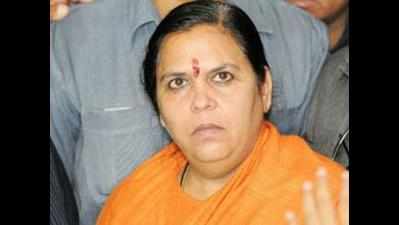- News
- City News
- varanasi News
- Water resource min's stand on dams appreciated by experts
Trending
This story is from June 26, 2016
Water resource min's stand on dams appreciated by experts
Tripathi further said that there were 70 proposed hydroelectric projects, in addition to other 34 already ongoing projects in this belt.

Union water resource ministry Uma Bharti. (File photo)
Varanasi: The stand of Union water resource ministry, headed by Uma Bharti, to oppose major hydroelectric projects proposed on Alaknanda-Bhagirathi-Mandakini river basins has been appreciated and welcomed by environmentalists and river scientists in the city.
"It is a big step taken by Uma Bharti's ministry for rejuvenation of the Ganga. It is a welcome move that will not only save the holy river but also prosper millions of people living in Gangetic plain," said noted environment scientist at Banaras Hindu University (BHU) and expert member of National Ganga River Basin Authority (NGRBA) BD Tripathi.
Tripathi further said that there were 70 proposed hydroelectric projects, in addition to other 34 already ongoing projects in this belt. During the UPA-II government the NGRBA had decided to declare 130km stretch from Gomukh to Uttar Kashi as eco-sensitive zone, and bar new hydro projects, he said adding, "The NGRBA had also decided to close 13 out of the ongoing 34 projects. Now, the stand of water resource ministry to oppose new dams of projects has come as a boon to the holy river, and it, if not backtracked, will have a far-reaching impact on Ganga's health."
The noted river scientist and former professor of civil engineering at BHU UK Chowdhary also appreciated the move and said, "We had been advocating for the same for years, as Himalayas are of sedimentary rocks. More the dam height means more depth in the reservoir that leads to more pore pressure. More pore pressure leads to land slide and increase in chemicals in reservoir water increasing the density of water. He further added, "Increase in water density means reduction in dissolved oxygen in water and enhancement in biochemical demand (BOD) load. Therefore, higher the dam means higher pollution load and more decrease in quality of the river water."
In its recent affidavit submitted to the Supreme Court, the ministry invoking the 'aviral dhara' (uninterrupted flow) promise of Modi government on the Ganga said efforts to clean the Ganga and restore its pristine purity at an estimated cost of Rs 20,000 crore would succeed only if Alaknanda, Bhagirathi and Mandakini rivers were allowed to flow without interruption by hydroelectric dams. The hydroelectric projects will adversely affect ecology of Himalayas leading to irreversible loss to Himalayan ecosystem and to the national river Ganga, which is the nation's identity and symbol of faith and heritage.
It is worthy to mention here that after the 2013 cloud burst causing Kedarnath tragedy in Uttarakhand, the SC had stayed green clearance to all the 70 proposed hydroelectric projects with generating capacity of over 9,000 MW in Alaknanda-Bhagirathi river basins.
"It is a big step taken by Uma Bharti's ministry for rejuvenation of the Ganga. It is a welcome move that will not only save the holy river but also prosper millions of people living in Gangetic plain," said noted environment scientist at Banaras Hindu University (BHU) and expert member of National Ganga River Basin Authority (NGRBA) BD Tripathi.
Tripathi further said that there were 70 proposed hydroelectric projects, in addition to other 34 already ongoing projects in this belt. During the UPA-II government the NGRBA had decided to declare 130km stretch from Gomukh to Uttar Kashi as eco-sensitive zone, and bar new hydro projects, he said adding, "The NGRBA had also decided to close 13 out of the ongoing 34 projects. Now, the stand of water resource ministry to oppose new dams of projects has come as a boon to the holy river, and it, if not backtracked, will have a far-reaching impact on Ganga's health."
The noted river scientist and former professor of civil engineering at BHU UK Chowdhary also appreciated the move and said, "We had been advocating for the same for years, as Himalayas are of sedimentary rocks. More the dam height means more depth in the reservoir that leads to more pore pressure. More pore pressure leads to land slide and increase in chemicals in reservoir water increasing the density of water. He further added, "Increase in water density means reduction in dissolved oxygen in water and enhancement in biochemical demand (BOD) load. Therefore, higher the dam means higher pollution load and more decrease in quality of the river water."
"The Himalaya is suitable for micro dams with 3-5mt height only, and by this technology we can generate 18,000 MW power without disturbing the quality of Gangajal with zero landslide," said Chowdhary, who is also the director of Mahamana Malaviya Institute of Technology for Ganga Management.
In its recent affidavit submitted to the Supreme Court, the ministry invoking the 'aviral dhara' (uninterrupted flow) promise of Modi government on the Ganga said efforts to clean the Ganga and restore its pristine purity at an estimated cost of Rs 20,000 crore would succeed only if Alaknanda, Bhagirathi and Mandakini rivers were allowed to flow without interruption by hydroelectric dams. The hydroelectric projects will adversely affect ecology of Himalayas leading to irreversible loss to Himalayan ecosystem and to the national river Ganga, which is the nation's identity and symbol of faith and heritage.
It is worthy to mention here that after the 2013 cloud burst causing Kedarnath tragedy in Uttarakhand, the SC had stayed green clearance to all the 70 proposed hydroelectric projects with generating capacity of over 9,000 MW in Alaknanda-Bhagirathi river basins.
End of Article
FOLLOW US ON SOCIAL MEDIA










